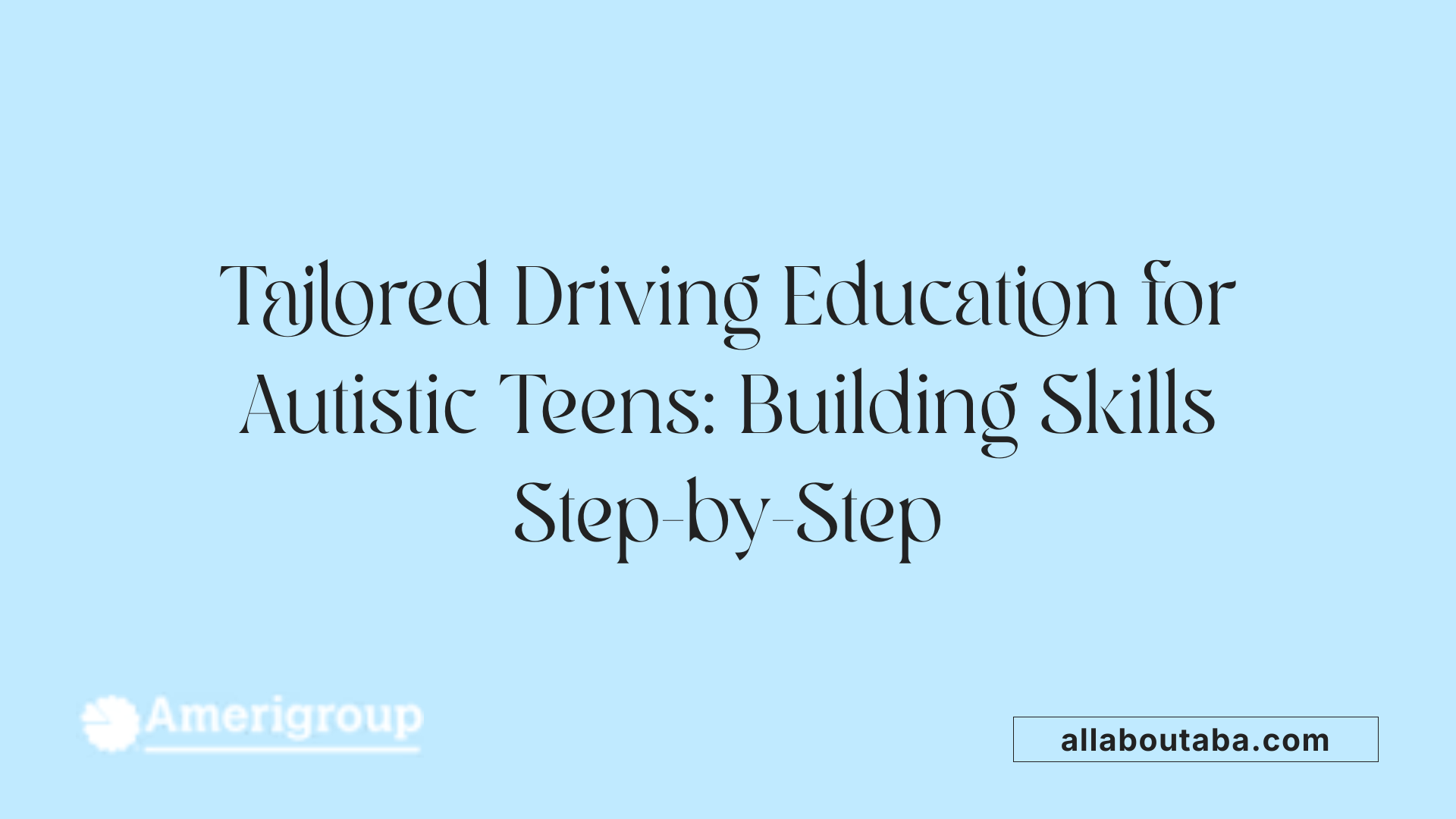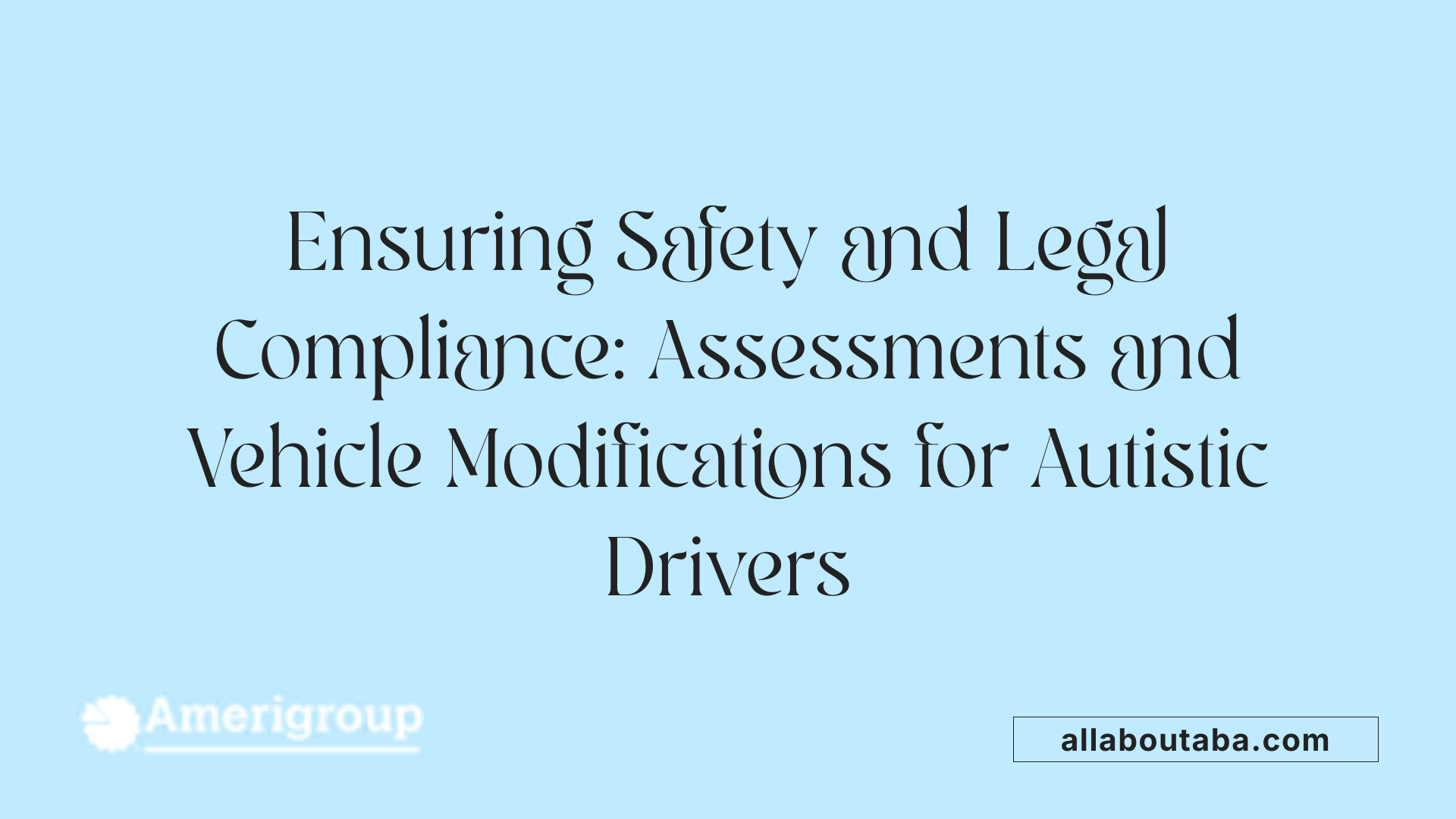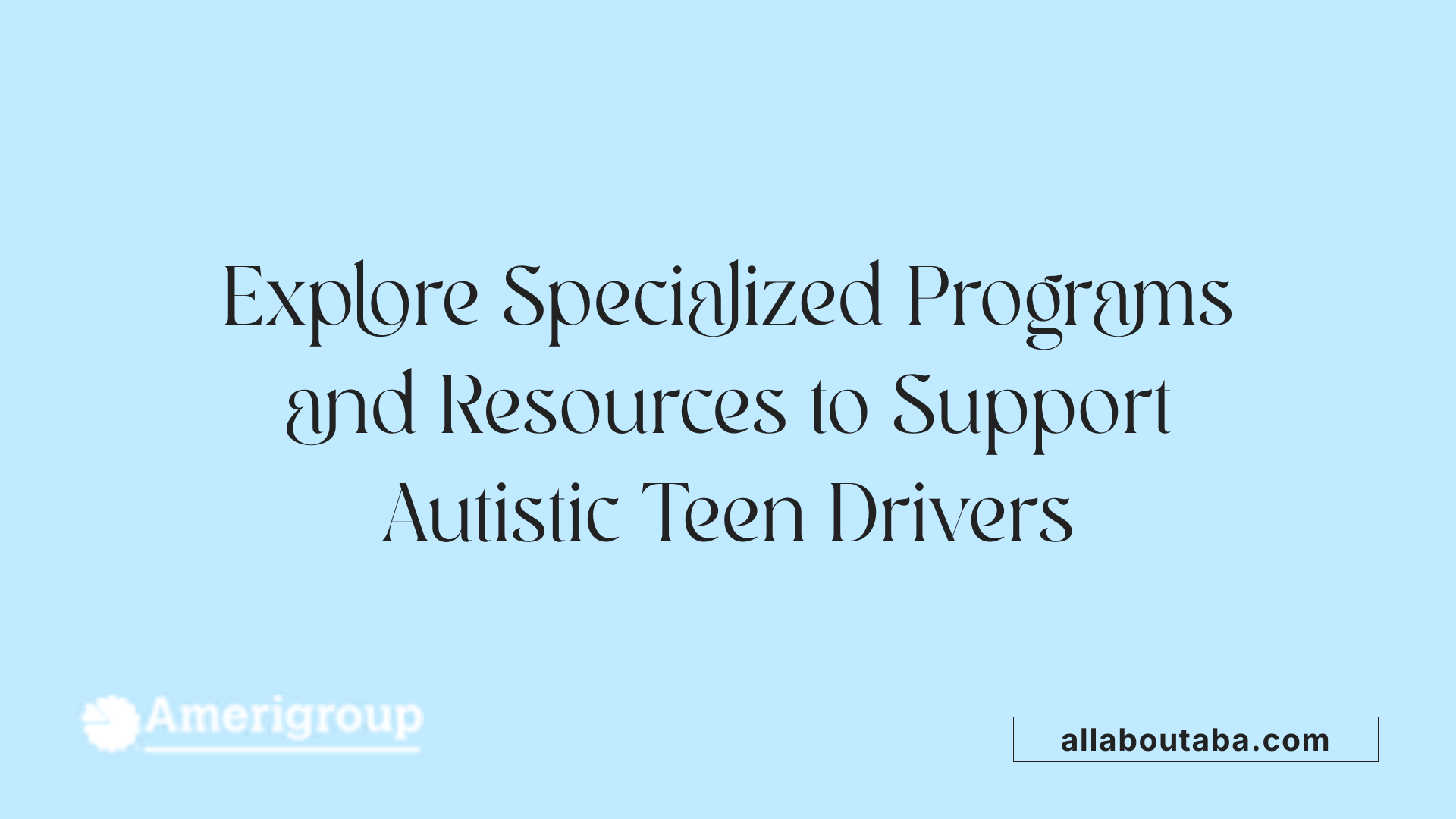How To Prepare Autistic Teens For Driver’s Education
Empowering Autistic Teens for Safe and Successful Driving Experiences
Learning to drive can be a transformative milestone for autistic teens, offering increased independence, confidence, and community access. However, preparing these young individuals for driver’s education requires a tailored approach that considers their unique sensory, communication, and learning needs. Recognizing the challenges and leveraging specialized programs, strategies, and resources can help families and professionals facilitate a safe and positive transition to driving. This article explores effective practices, safety assessments, legal considerations, and resources to support autistic teens on the road to independence.
Understanding Autism’s Impact on Driving Skills

What is known about the impact of autism on the ability to learn to drive?
Autism can influence various skills essential for driving, such as communication, sensory processing, and executive functioning, often requiring tailored instruction and support. While autistic individuals can legally obtain a driver's license after meeting standard requirements, they generally take longer to progress through licensing stages and may need individualized training strategies, such as breaking tasks into small steps and practicing repeatedly.
Challenges faced by autistic drivers include difficulty detecting hazards, managing multiple stimuli, and interpreting social cues, but they also tend to exhibit strengths like rule adherence and carefulness.
Research indicates that crash rates for autistic drivers are comparable to or lower than those of non-autistic drivers, though understanding implicit cues may be more challenging. Supporting autistic teens through specialized therapies, familiar routes, and gradual skill-building can enhance their driving safety, and consultations with healthcare professionals or driving specialists can provide valuable guidance.
How does autism influence learning to drive?
Autism’s impact on learning to drive involves difficulties with sensory sensitivities, executive functioning, and social perception. Autistic individuals often need more time and tailored methods to master driving tasks.
Despite these challenges, many autism traits—such as rule-following and meticulousness—can contribute positively to driving. Customized instruction that incorporates visual supports, clear communication, and gradual exposure can facilitate safer learning experiences.
Overall, with proper support, many autistic teens can develop competent driving skills. Understanding their unique needs and providing specialized training can lead to successful outcomes, improving independence and safety.
What challenges might autistic individuals face in driver’s education, and how can these be addressed?
Several obstacles may arise during driver’s education for autistic learners. Sensory sensitivities to noise, light, or crowded environments might cause overload.
Communication challenges, like literal interpretation of instructions, can hinder comprehension of complex driving concepts. Anxiety about new experiences or social situations can also impair focus.
Motor coordination issues or difficulties understanding implicit cues like gestures and social signals on the road may increase safety concerns.
To mitigate these challenges, educators can implement several strategies:
- Use small, manageable steps and break skills into parts.
- Provide visual supports such as checklists, diagrams, and route maps.
- Keep lessons short, with frequent breaks to avoid overload.
- Practice in low-stress settings like parking lots and quiet streets.
- Offer consistent routines and familiar routes to reduce anxiety.
- Incorporate gradual exposure to traffic complexities.
- Use virtual assessments and simulations for initial skill-building.
Positive reinforcement and clear, concise language further enhance learning and confidence.
Involving healthcare professionals early on helps tailor training according to individual sensory and cognitive needs. Patience and flexibility are fundamental when supporting autistic teens in becoming safe, confident drivers.
Strategies for Effective, Supportive Driving Instruction

How can driving instruction be tailored to support autistic teens?
Driving education for autistic teens benefits from individualized approaches that acknowledge their unique learning styles and challenges. Tailored instruction often involves breaking down driving skills into small, manageable steps and providing a predictable, low-stress learning environment.
Specialized instructors who are trained as occupational therapists or driver rehabilitation specialists can assess each teen's capabilities, sensitivities, and needs. These professionals use adaptive teaching methods such as structured routines, environmental modifications, and gradual exposure to complex driving scenarios.
Incorporating tools like driving simulators, visual aids—including detailed maps, checklists, and landmarks—and role-playing scenarios enhances predictability and understanding. Simulators offer safe practice environments, though their transferability to real-world driving may be limited.
Emotional regulation techniques, such as calming strategies and support for executive functioning, further boost confidence. For example, programs like Cognitive Behavioral Intervention for Driving (CBID) can help teens manage anxiety and develop better self-regulation.
Gradually increasing exposure—from practicing in parking lots to more complex roads—enables teens to build skills steadily. Familiarity with the vehicle, route planning, and establishing consistent routines support smoother learning.
Overall, customizing lesson plans that consider sensory sensitivities, communication preferences, and individual strengths significantly improves safety, competence, and independence for autistic teen drivers.
What behavioral and communication strategies support learning to drive for autistic teens?
Effective learning for autistic teens hinges on clear communication and supportive behavioral strategies. Visual supports such as checklists, step-by-step diagrams, and pictorial representations of landmarks make instructions more concrete and reduce ambiguity.
Using straightforward, concise language helps teens better understand rules and instructions, especially since literal interpretation can sometimes pose challenges. Commentary driving, where the instructor verbalizes their actions as they occur, develops the teen’s observation skills and helps them anticipate driving behaviors.
Repetitive practice and role-playing different traffic scenarios prepare teens for real-world challenges, gradually increasing their comfort and competence. This approach is particularly useful for building familiarity with complex or stressful situations.
Positive reinforcement—praising correct responses and progress—encourages continued effort and reduces anxiety. A calm, patient, and empathetic teaching style also aids in lowering stress levels, making the learning process more effective.
Breaking tasks into smaller steps prevents feelings of being overwhelmed, while consistent routines and structured lessons foster a sense of security and predictability. Incorporating visual supports like diagrams and road maps helps reinforce understanding and memory.
Combining these behavioral and communication strategies creates a supportive framework that addresses individual needs, promotes skill mastery, and enhances overall safety and confidence in young drivers on the spectrum.
Safety, Assessment, and Legal Considerations

What safety considerations and assessments are important for autistic teen drivers?
Ensuring safety for autistic teen drivers involves a comprehensive approach that recognizes their unique needs and challenges. It starts with individualized assessments conducted by professionals such as occupational therapists or driver rehabilitation specialists. These evaluations examine multiple aspects, including judgment, motor skills, executive functioning, and sensory sensitivities.
Family members and healthcare providers should collaborate to evaluate the teen's readiness through practical means like simulator training, parent-supervised practice drives, and exposure to real-world driving in low-stress environments. Special attention should be given to sensory sensitivities, reaction times, and social cue recognition, which are crucial for safe driving.
To support safe driving, vehicle modifications such as sensory-friendly controls, adaptive equipment, or modifications tailored to individual needs can be implemented. Visual supports like checklists or diagrams assist understanding of driving tasks, while communication aids—such as the Michigan Department of State’s Communication Impediment Designation—help law enforcement recognize and effectively communicate with autistic drivers.
Ongoing evaluation, combined with professional guidance, strengthens driving skills and safety. Patience and structured training programs, including repeated scenario practice, are essential to help autistic teens develop confidence and refine their driving abilities safely.
Are there legal or vehicle modification considerations for autistic teens?
Legally, autistic teens must meet standard licensing requirements, which include obtaining a learner’s permit, passing written tests, and successfully completing behind-the-wheel assessments. Having autism or related conditions does not automatically disqualify a teen from obtaining a license, but they may be entitled to certain accommodations.
Vehicle modifications and adaptive equipment can significantly enhance safety and accessibility. These can include hand controls for steering and acceleration, swivel seats for easier transfer, wheelchair ramps, or pedal extenders. Consultations with driver rehabilitation specialists are critical to select appropriate modifications aligned with the teen’s physical and cognitive abilities.
Funding for modifications may be accessible through insurance plans, rebates offered by vehicle manufacturers, or government programs. It is vital to ensure modifications comply with safety standards and licensing regulations. Choosing qualified, certified specialists ensures proper installation and adherence to safety laws.
Legal considerations also involve privacy and safeguarding designations—such as adding communication impairment identifiers, which assist law enforcement in interactions and ensure respectful, effective communication.
Overall, integrating proper assessments, vehicle adaptations, and legal compliance enhances the chances of safe, independent driving for autistic teens, fostering greater mobility and confidence.
Resources, Programs, and Support Networks for Autistic Teen Drivers

What resources or programs are available to support autistic adolescents in learning to drive?
A variety of tailored resources and programs now support autistic teens in their journey toward driving independence. Specialized driver education offerings like 'Autism drives' are designed with input from autistic individuals to focus on safety, decision-making, and essential driving skills. These programs typically include both classroom instruction and practical on-road experience, emphasizing a low-stress environment.
DrivingMBA stands out as a comprehensive option, providing assessment-based training, virtual simulation, and on-road instruction specifically tailored for neurodivergent learners. Their goal is to reduce risks associated with driving while promoting proficiency and confidence.
Ability KC offers a specialized driver evaluation and behind-the-wheel training service, managed by licensed specialists experienced in working with individuals with disabilities, including autism. They incorporate adaptive equipment and focus on safety protocols.
Life Driving Academy has developed programs that cater specifically to teens with ADHD and autism, including extensive parent involvement, extra driving hours, and a focus on fostering skills and confidence.
Additional helpful resources include state-specific licensing guides, insurance information, and research studies on autism and driving, which help families make informed decisions and plan safe transitions to independence.
Supporting Safe Driving Journeys for Autistic Teens
Equipped with understanding, tailored strategies, and appropriate resources, parents, caregivers, and professionals can help autistic teens navigate driver’s education confidently. Emphasizing patience, gradual exposure, and supportive environments, they can facilitate safe, successful driving experiences that promote independence and community engagement for these young individuals. Embracing specialized programs and ongoing assessments ensures that each teen’s unique needs are addressed, ultimately fostering safer roads and transforming independence into a realistic, positive goal.
References
- Supporting Autistic Individuals in Driver Education: A Systematic ...
- 6 Helpful Tips for Navigating A Driver's License With Autism
- Driving with autism: Helping decide if they want to learn how to drive
- Autism and driving | Ohio State Health & Discovery
- [PDF] Driving with Autism Brochure - Office of the Texas Governor
- Driving and Teenagers on the Spectrum: Is Your Child Ready?
- Teaching the Person With Autism HOW to DRIVE
Other articles
Recent articles

Best Practices For Autism-Friendly Fitness And Recreation Centers

Best Ways To Promote Healthy Social Media Use For Autistic Teens

How To Help Autistic Children Cope With Public Speaking

Autism And Strategies For Managing Unexpected Changes

Best Podcasts About Autism For Parents And Educators

Autism And The Impact Of Seasonal Changes On Behavior

The Role Of Diet In Managing Co-Occurring Conditions With Autism

Sleep Challenges In Autism And Practical Solutions

Best Ways To Build Daily Routines For Autistic Children

Best Practices For Supporting Autistic Entrepreneurs

Autism And Strategies For Navigating Large Social Gatherings

Adaptive Sports And Recreational Activities For People With Autism

Autism And The Benefits Of Story-Based Learning Activities

Understanding The Role Of Play In Autism Development

Autism And The Impact Of Environmental Noise On Learning

How To Create Autism-Friendly Community Spaces

Autism And Chronic Health Conditions: What To Know

The Role Of Care Managers In Autism Life Planning

How To Teach Social Boundaries To Autistic Children

How Autistic Individuals Experience Empathy Differently

How To Support Autistic Employees In Remote Work Settings

Autism And The Relationship Between Motor Skills And Learning

How To Create Community Resource Guides For Autism Families

How To Teach Daily Living Skills To Autistic Teens

Autism And The Impact Of Mind-Body Practices On Stress Reduction

Autism And The Benefits Of Outdoor Group Activities

How To Create Autism-Friendly Sensory Paths In Schools

Best Practices For Autism-Friendly Park And Recreation Areas

Autism And Strategies For Reducing School Refusal

Supporting Autistic Individuals In Public Speaking

The Role Of Diet In Managing Autism Symptoms

The Benefits Of Gardening Clubs For Autism Social Development

How To Prepare Autistic Children For Dental Visits

Autism And Employment: Career Paths That Work

Best Practices For Autism-Friendly Hotels And Lodging

The Impact Of Screen Time On Autism Development

Autism Screening Tools For Early Childhood

The Role Of Physical Exercise In Autism Therapy

Best Strategies For Supporting Autistic College Students

The Role Of Technology In Autism Early Detection

Sensory-Friendly Classroom Design Ideas For Autistic Students

The Role Of Speech Therapy In Building Social Communication Skills

Best Strategies For Handling Autistic Burnout In Adults

Autism And The Importance Of Predictability In Routine

Autism And Peer Education: Teaching Acceptance In Schools

Best Practices For Sensory-Friendly Libraries And Reading Rooms

Self-Advocacy Skills For Autistic Adults

The Role Of Technology In Autism Peer Communication

Promoting Physical Activity In Children With Autism

How To Prepare Autistic Children For Medical Procedures

The Role Of Social Media In Autism Advocacy And Awareness

The Impact Of Sensory Rooms In Public Facilities For Autism

How To Create An Autism-Friendly Holiday Celebration

Best Practices For Inclusive Education For Autistic Students

Autism And Mental Health: Recognizing Signs Of Distress

Best Practices For Sensory-Friendly Waiting Rooms

The Role Of Teachers In Early Autism Red Flag Identification

Autism-Friendly Housing Design Features

Autism-Friendly Housing Design Features

How Environmental Modifications Improve Autism Outcomes

Autism And Technology-Based Learning Tools

Supporting Autistic Children Through Changes In Routine

The Link Between Autism And Working Memory Challenges

Best Practices For Autism-Friendly Cooking Classes

Autism And The Benefits Of Structured Music Lessons

Best Books To Teach Kids About Autism Acceptance

Sensory Diets And Their Benefits For Autism Management

How To Prepare Autistic Teens For Driver’s Education

How To Teach Autistic Teens About Healthy Relationships

The Role Of Visual Prompts In Building Daily Habits For Autism

Addressing Sleep Regression In Children With Autism

Understanding Social Stories And How They Help Autistic Children

Navigating Insurance Coverage For Autism Therapy Services

How To Prepare Autistic Adults For Independent Travel

Supporting Autistic Individuals In Volunteer Work

How Mindfulness Practices Can Support Autism Well-Being

Understanding Hyperfocus And Special Interests In Autism

Understanding Stimming As A Self-Regulation Tool

Sensory-Based Interventions For Autism At Home

Best Ways To Introduce Self-Advocacy In Autistic Teens

Best Ways To Support Autistic Employees In Customer Service Roles

Best Practices For Autism-Friendly Volunteer Programs

Autism And The Benefits Of Sensory Play For Emotional Growth

Autism And Strategies For Building Peer Relationships

Understanding How Autism Affects Memory Processing

Autism And Strategies For Building Coping Skills In Teens

The Role Of Parent Training In Autism Intervention Programs

Autism-Friendly Workplace Accommodations

Using Visual Timers For Autism Time Management

What Is ABA Therapy?

Autism and Sleep

Do Plastic Toys Cause Autism?

Autism Facial Expressions

Autism and Motor Skills

Which Parent Carries The Autism Gene?

Autism Symbols & Colors

Rett Syndrome: Symptoms, Causes, and Treatment

Self-Diagnosed Autism

Autism and Sound Sensitivity

Autism With Speech Delay
We’re All About You, Your Family, and Your Child

